503 Beardies-The Harsh Haired aHerders
BEARDING THE SHEEPDOG
by David Hancock
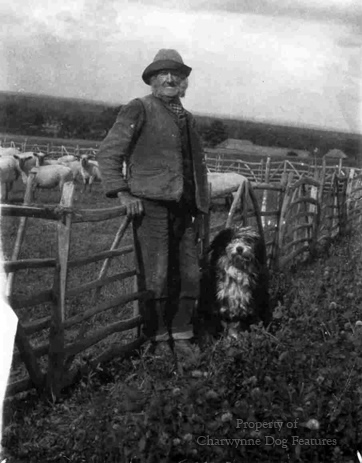
 Livestock-farming, the rearing, herding and eventually getting stock to market, has long been a hard living not a gentle pastime. Before the days of rail and wheeled transporters, the sheep and cattle, and therefore the shepherds and their dogs, 'hoofed' it. The dogs were either robust or they didn't survive. The drovers needed substantial dogs, able to travel huge distances and protect the stock, as the bouviers demonstrate. The Lake District farmers needed a leggier dog than those in Kent; the moors' shepherds needed robust, agile dogs with immense stamina. Function, as always with dogs, decided form.
Livestock-farming, the rearing, herding and eventually getting stock to market, has long been a hard living not a gentle pastime. Before the days of rail and wheeled transporters, the sheep and cattle, and therefore the shepherds and their dogs, 'hoofed' it. The dogs were either robust or they didn't survive. The drovers needed substantial dogs, able to travel huge distances and protect the stock, as the bouviers demonstrate. The Lake District farmers needed a leggier dog than those in Kent; the moors' shepherds needed robust, agile dogs with immense stamina. Function, as always with dogs, decided form.
In time, transhumance led to the development of the mountain dogs/flock guardians, herding needs gave us the shepherd dogs and within them, specialists committed to the 'living fence' role, like the GSD, or the flock herders, like the Bearded Collie of Scotland and some parts of England. The Border Collie may have got its name, not from the border of Scotland and England, but from its skill on the borders of the flock. But the Beardie's name came from its coat and its appearance.
The Beardie group is represented in most areas of Europe: the Cao da Serra de Aires from Portugal, the Briard and the Picardy from France, the Pyrenean sheepdog, the Gos d'Atura of Catalonia, the German Sheep Poodle, the Lowland Sheepdog of Poland, the South Russian Owtcharka, the Schapendoes of Holland and, from the British Isles, the Bearded Collie, the Old English Sheepdog and the now-extinct Old Welsh Grey, Blue Shag and Smithfield Sheepdogs. This group of dogs is also represented in the Egyptian Sheepdog, the Armant, and the Patagonian Sheepdog, which may be an offshoot of the Old Welsh Grey, introduced by migrating Welsh settlers. The Tibetan 'Terrier' too may belong here.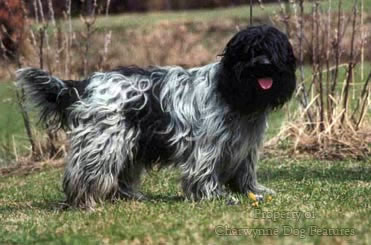
In his The Illustrated Book of the Dog of 1881, Vero Shaw quotes The Live Stock Journal of 1878, in which Gordon Phillips of Glenlivet writes on the 'rough-coated' Collie. It is forgivable to assume that his words refer to the pedigree Rough Collie, but he was describing a shaggy sheepdog, not the longer-haired variety of the Scottish Collie. A precis of his words gives considerable value to Bearded Collie fanciers. Phillips wrote that: It is seldom if ever seen pure-bred in the north of Scotland; it is shaggy-coated, thick-skinned, with short powerful limbs; shepherds prefer it for its endurance of cold and fatigue and its ability as a driver, considering it the best dog for sheep; the size of an ordinary collie but a good deal deeper-chested and flatter in the forehead; a dark grey in colour, short-tailed, at home among the drift and snow, finely adapted for hill climbing.
He wrote that this type of shaggy-coated collie instinctively made a wide sweep, with shepherds stating that they can safely trust 200 or 300 sheep 'to the sagacity of this valuable dog, which does not hurry or push, but drives them as coolly and as cautiously as if its master were present'. Vero Shaw produced an illustration of the collie described by Phillips, adding that 'It is impossible to give any standard for judging this variety. General appearance, tail, strength, and shagginess without too much length of coat, should be taken into consideration'. Shepherds were known to refer to such collies as goat-haired collies; goats also of course having beards. 
The goat-haired sheepdogs have long existed as a distinct type all over Europe, but all lack coverage in canine literature. If you compare their distribution with that of the big flock-guardians of the high pastures like the Maremma, the Estrela Mountain dog, the Caucasian Owtcharkas, the Kuvasz, the Tibetan "Mastiff" and the Bergamasco, and then with the various types of Dutch and Belgian shepherd dogs, the Border Collie, the Beauceron, the Algerian Sheepdog, the Berger de Picardie, the rough and smooth Collies and the now extinct Wels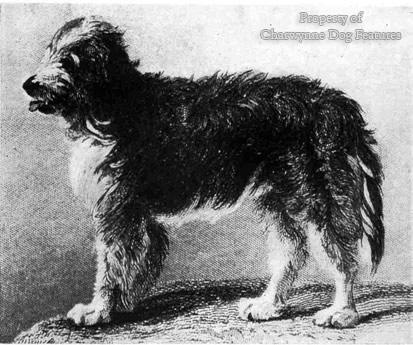 h Hillman, you can soon see how climate, function and terrain determined type.
h Hillman, you can soon see how climate, function and terrain determined type.
Against that background therefore, I don't believe there is really any need to seek an origin for, say, the Bearded Collie in dogs off a Polish ship in the 16th century or any other foreign ancestry. If you want a long-haired sheepdog, breed one selectively from the longer-coated specimens of sheepdog stock! The international distribution of dogs that herd sheep, long-haired, rough-coated or smooth, demonstrates that the differing coat-lengths occur naturally and have been perpetuated and enhanced by line-breeding down the centuries to stabilise one particular coat. In time a desired coat length can be fixed and the various breeds, or varieties within a breed, evolved. Not surprisingly, coat lengths can be linked with specific needs in particular areas and developed with other breed characteristics. With pedigree dog-breeding being only just over a century old it is easy to overlook the fact that breed-types evolved in many cases over at least five centuries.jpg) .
.
In some areas where prolonged wind-chill exposure was met, felted coats like those of the Komondor, the Bergamasco and the Puli were needed. But the coat texture and length produced was originally always in pursuit of a purpose and never appearance. The herding breeds were developed by essentially practical men, in eternal combat against the elements and wild predators, men who quickly discarded weedy or faulty dogs. I know of no old print or early photograph or painting which depicts the longer-haired herding breeds with the excessive length of coat displayed by many of their successor breeds at today's shows. 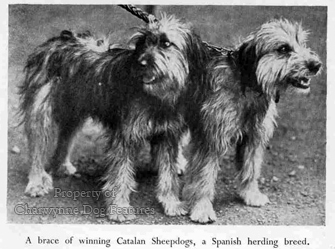
Early in the last century HA Titley, who contributed so much to the development of the Old English Sheepdog, wrote: "During recent years there has been an increasing tendency to over-development of the coat and especially for show purposes, but it is an adverse handicap for 'working' dogs which are exposed to all weathers, mud, and dusty roads." Fifty years or so ago James Garrow wrote to Mrs GO Willison, who launched the show career of the Bearded Collie: "The Beardie was essentially a worker, famed for fleetness and brains, kept by butchers, farmers, etc...The coat should not be overlong and of a raw harsh texture...Have you drawn up the standard for the K.C. yet? You want to emphasise the rule on coat." Most of the Beardies I see in the show ring nowadays display such a length of silky coat as to obscure the natural lines of the dog's body, which is contrary to the breed standard. The standard of the Old English Sheepdog places no restriction on the length of coat at all.
I can find no evidence nor any credibility in the stories that the longer-haired herding dogs all originated in one country and spread out from there. I believe it is likely that the herding dogs brought south by the migrating Indo-Europeans roughly four thousand years ago had the prototypal dogs and since then they have gradually evolved into the types and with the physical features demanded by location, function and local preferences. In Britain, Bearded Collies have been interbred with the Old English type and the working sheepdogs of the Border Collie type for centuries. This is not to say of course that in some areas a definite type was not preferred and kept distinct. I believe it is likely that the shaggier sheepdogs were called Beards (or Hirsels) in Scotland, Haggards in Ireland, Greys in Wales and Shags in England, where the bigger ones were used as drovers' dogs and dubbed Bobtails.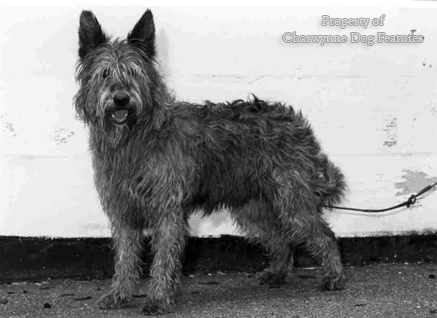
The sheep-herding dogs quite often went with flocks of sheep when these changed hands, and sometimes countries too. It is, in my view, quite absurd to claim that the different herding breeds, especially when they occur in the same country, are completely unrelated. It is entirely fair however to state that line-breeding for distinct 'type' has been practised for several hundred years in a number of areas. In the Pyrenean region, the dog from Abrazzie was considered by Megnin to be the ideal for the standard of the Pyrenean Sheepdog, with the Bagneres type having the best head, while the thick-set St-Beat dog was likened to a miniature Bobtail (Old English Sheepdog).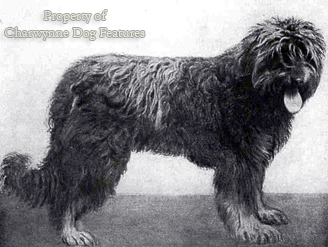
Comparable thinking has led some to claim that Peebleshire is the true home of the Beardie, Dorset the real home of the Bobtail, The Lake District the original base for the Border Collie and Snowdonia the home of the Old Welsh Grey. But Beardies have long been favoured in north-west England and, being utilised by drovers, could be found wherever there was a vibrant sheep trade; the Smithfield Sheepdog, the bigger Beardie-type, being associated with the sheep-market towns and areas of eastern England. There were differences between the longer-haired sheepdogs found in the Highlands and those working in the border regions.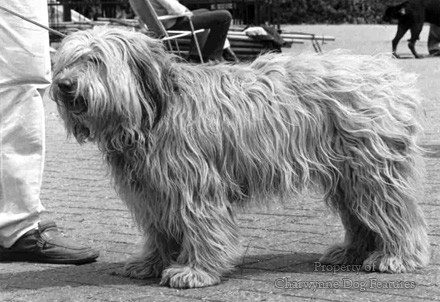
Beardies work in a different style from that of their shorter-haired fellow working sheepdogs; although they can display the same ground-hugging creeping gait, they are not silent or "strong-eyed" but excel at collecting and then retaining sheep in big groups. This capability made them most useful to drovers and butchers. The goat-haired collies were favoured by renowned drovers such as McDonald of Skye around 1930 then shepherds like Tom Muirhead of Dunsyre a few decades later. Br ian Plummer, the countrysports writer bought Muirhead's kennel of Beardies, describing the white-headed ones as willing to 'face the devil himself', because of their hardness. Now Graham Nicholson's Working Bearded Collie Foundation is continuing their work.
ian Plummer, the countrysports writer bought Muirhead's kennel of Beardies, describing the white-headed ones as willing to 'face the devil himself', because of their hardness. Now Graham Nicholson's Working Bearded Collie Foundation is continuing their work.
I understand that in the early days of trying to breed pure Beardies it was not unusual to find a couple of pups in a litter looking more like Border Collies. The early registrations of sheepdogs with the International Sheepdog Society listed rough, smooth and bearded types but farmers often interbred dogs with different coats and ear-carriage. The Bobtail was also used as a drovers' dog, like the Bouviers on mainland Europe; I can remember an old grazier on Salisbury Plain fifty years ago telling me how the instinctive skills of the Bobtails varied: some preferring to lead the sheep, others to drive them as a flock and some to guard a flank. This instinctive behaviour occurred in young untrained dogs.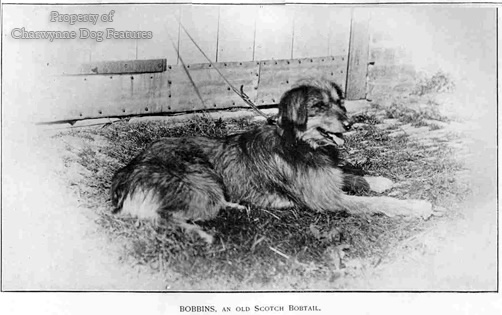
Other bobtailed dogs, somewhat smaller than ours, are the Berger des Pyrenees, the Gos D'Atura of Catalonia (recently recognised by our KC) and the Polski Owcaarek Nizinny or Polish Lowland Sheepdog, although some specimens in these breeds which are born with tails can be seen undocked. The Cao da Serra de Aires from Portugal, known as the "monkey dog " from its heavy eyebrows, beard and moustache and the Catalan Sheepdog both feature the full tail, the latter breed carrying it gaily when working. The Portuguese dog, the Schapendoes of Holland and our own Bearded Collie are astonishingly similar in appearance, a significant fact if one day gene pools need enlarging.
I understand that every Bearded Collie registered in the world can be traced back to just twelve dogs, a small genetic base. With just one dog registered in 1948, we had nearly two thousand registered forty years later, now reduced to well under a thousand being registered annually. This fine breed will need wise breeders if it is to retain its characteristics, robustness and virility. Already, in Canada, I've seen the breed described as having set a record for "the breed ruined in the shortest possible time". It is surely vital to breed every ancient breed true to its heritage rather than for those who see only cosmetic appeal. The Beardie should be a medium-sized dog not a rival to the Old English Sheepdog. The Beardie should be long-backed and its eyes should be visible not concealed. I like the phrase used in the outline description of the breed in Our Dogs of December 17th, 1898: "The face should have a sharp, inquiring expression". Facial expressions can tell you a lot about dogs as well as people!
Beardies are clever dogs and this, together with their determination and tractability, has led lurcher breeders to utilise their blood, as have Deerhound breeders of old, although no shepherd would want Deerhound blood in his stock. This particular group of herding dogs readily arouse our affection; it is even more important that they are afforded our respect, respect for their true type and soundness. It is disrespectful just to breed to meet show ring criteria.